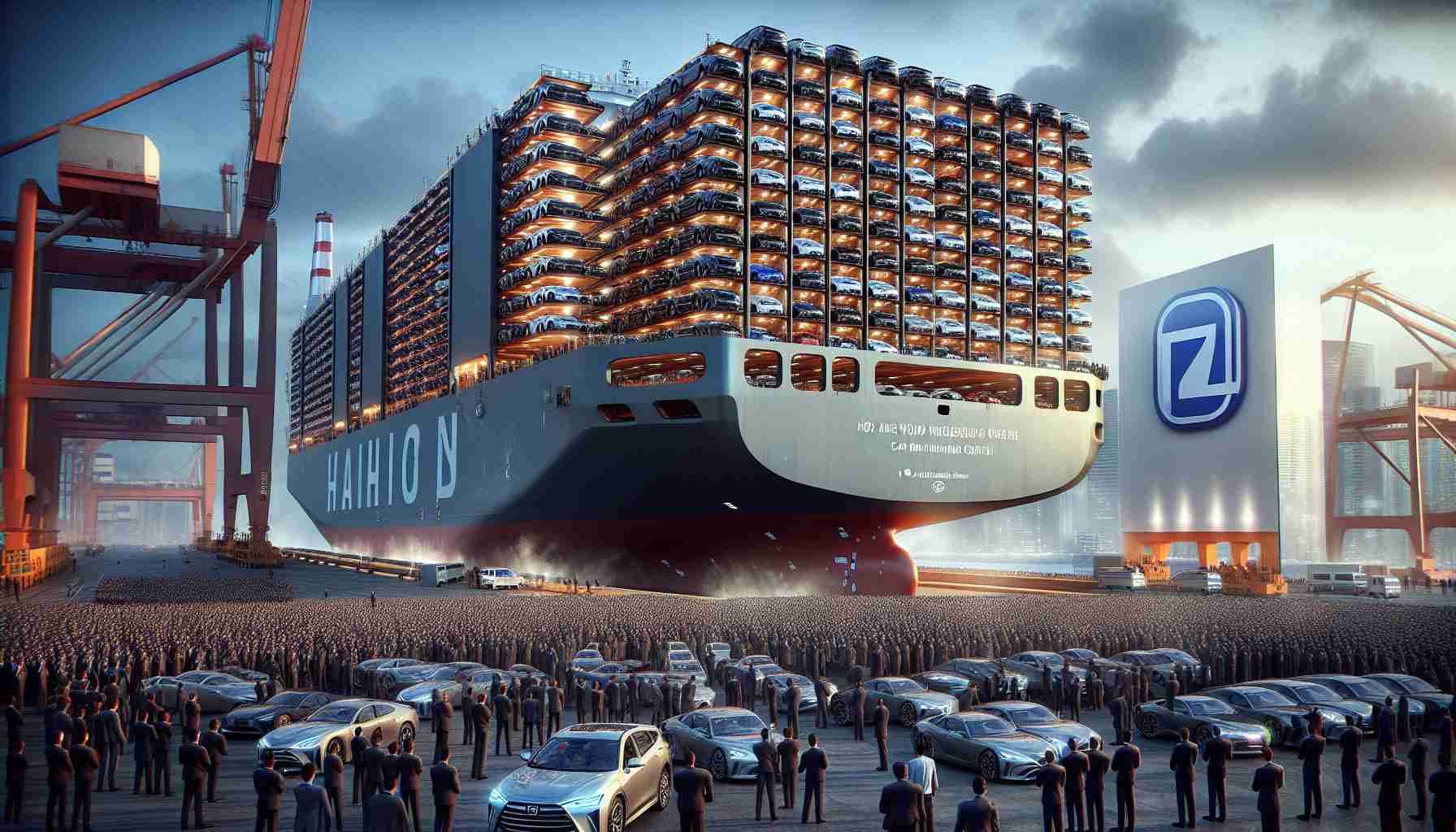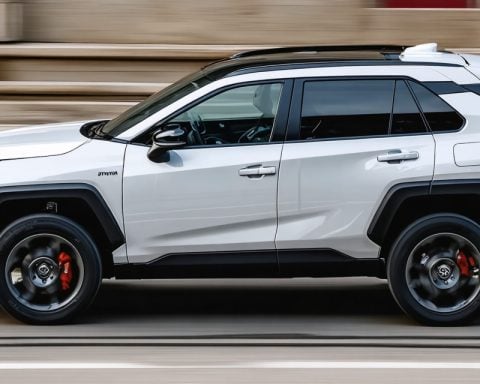A New Era in Vehicle Transportation
The automotive industry is witnessing a groundbreaking development as BYD Auto reveals its largest vehicle carrier ever, capable of transporting a staggering 9,200 cars across oceans. Named the ‘BYD Shenzhen’, after the company’s headquarters, this massive vessel has just made its debut at Yangzhou port, located northwest of Shanghai.
The impressive dimensions of the ‘BYD Shenzhen’, measuring 219 meters long and 37.7 meters wide, are complemented by its maximum speed of 18.5 knots. This vessel is a testament to BYD’s ambitions to expand its international footprint, especially after a notable sales surge in 2024.
Not only is this ship built for capacity, but it also aligns with environmental goals. Featuring LNG dual-fuel technology, it can run on both liquefied natural gas and traditional marine fuels. Equipped with energy-saving devices and BYD’s specialized stationary storage batteries, the vessel minimizes its carbon footprint during its operations.
This is the fourth roll-on/roll-off (ro-ro) ship launched by BYD in just a year, as the company moves to solidify its presence in global markets. The fleet’s previous vessels have successfully navigated routes to Europe and Brazil. Furthermore, BYD is currently expanding its market reach, having gained significant traction in countries like Japan and South Korea, positioning itself as a formidable competitor against established automakers.
The Global Impact of BYD’s New Vehicle Carrier
BYD Auto’s unveiling of the ‘BYD Shenzhen’ is not just a milestone for the company, but a significant indicator of broader trends in the automotive and maritime industries. As vehicle transportation increasingly shifts towards sustainable practices, this development echoes a larger societal need for environmentally responsible shipping solutions. With the capacity to transport 9,200 vehicles, the ‘BYD Shenzhen’ positions itself as a pivotal player in meeting the demand for efficient and sustainable vehicle logistics, driven by the increasing global emphasis on reducing carbon emissions.
Moreover, the expansion of BYD’s capabilities will influence global economies by promoting cross-border vehicle sales. Markets in regions such as Europe and South America are experiencing growth due to the influx of electric and hybrid vehicles, compelling traditional automakers to adapt swiftly. As competition intensifies, consumers could benefit from a wider array of environmentally friendly options, driving down prices and boosting innovation.
In terms of environmental impact, the LNG dual-fuel technology used in the BYD carrier marks a significant shift toward cleaner maritime logistics. By adopting such technologies, the global shipping industry may begin to embrace more sustainable practices, potentially leading to a 1 billion tons reduction in CO2 emissions by 2030, as advocated by recent maritime emission studies.
In conclusion, as the automotive industry continues moving towards electrification and sustainability, innovations like the ‘BYD Shenzhen’ will play a crucial role not only in shaping transportation policies but also in redefining the global manufacturing landscape. The long-term significance of these advancements could mobilize new practices across industries, setting a trend towards a more interconnected and environmentally conscious global economy.
Revolutionizing Vehicle Transport: BYD Auto Sets New Standards with Innovative Vessel
A New Era in Vehicle Transportation
The automotive industry is undergoing a significant transformation, driven by advancements in logistics and environmental sustainability. BYD Auto has recently made headlines with the unveiling of its largest vehicle carrier to date, the ‘BYD Shenzhen’. Capable of transporting an impressive 9,200 cars, this vessel marks a significant milestone in vehicle transportation, aiming to meet the increasing global demand for electric and traditional vehicles.
Specifications and Features
The ‘BYD Shenzhen’ is a marvel of engineering, boasting dimensions of 219 meters in length and 37.7 meters in width. Running at a top speed of 18.5 knots, it combines capacity and efficiency. This innovative ship is designed not only for vast cargo capacity but also to support BYD’s commitment to environmental sustainability.
– Fuel Efficiency: The vessel features LNG dual-fuel technology, allowing it to utilize both liquefied natural gas and traditional marine fuels, thereby reducing emissions significantly.
– Energy Conservation: Equipped with energy-saving devices and advanced stationary storage batteries developed by BYD, the ‘BYD Shenzhen’ minimizes its carbon footprint during transportation, setting new benchmarks for eco-friendly logistics.
Growing Presence in Global Markets
This launch is part of BYD’s strategic plan to expand its international reach, particularly in regions experiencing a surge in electric vehicle adoption. The company has already witnessed a notable increase in sales throughout 2024, reinforcing its position in competitive markets.
BYD has previously launched multiple roll-on/roll-off (ro-ro) ships, marking this vessel as the fourth in under a year. Its growing fleet has efficiently serviced routes to Europe and Brazil, and the company continues to strengthen its footing in Asia, with significant growth in Japan and South Korea.
Pros and Cons of BYD’s Shipping Innovations
Pros:
– High capacity: Ability to transport over 9,000 vehicles, optimizing logistics.
– Environmental benefits: Use of LNG and energy-saving technologies reduces ecological impact.
– Global reach: Enhances BYD’s competitive edge in international markets.
Cons:
– High initial investment: Developing such advanced vessels requires substantial capital.
– Regulatory challenges: International shipping regulations may impact operations.
– Market fluctuations: Dependence on the automotive market can introduce volatility.
Future Trends and Innovations
As the demand for sustainable transportation grows, companies like BYD are paving the way for innovations in shipping technology. With a focus on reducing carbon emissions and increasing operational efficiency, we can expect more automakers to follow suit by adopting similar eco-friendly practices.
Conclusion
The launch of the ‘BYD Shenzhen’ represents a pivotal moment in vehicle logistics, combining capacity, speed, and sustainability. BYD Auto is not only expanding its footprint in the automotive sector but also setting benchmarks for environmentally responsible practices in shipping. As the company continues to innovate and adapt, it stands to play a crucial role in the future of global vehicle transportation.
For more information on automotive innovations and sustainability trends, visit BYD Auto.













